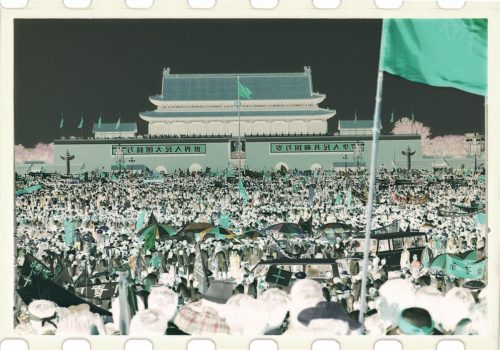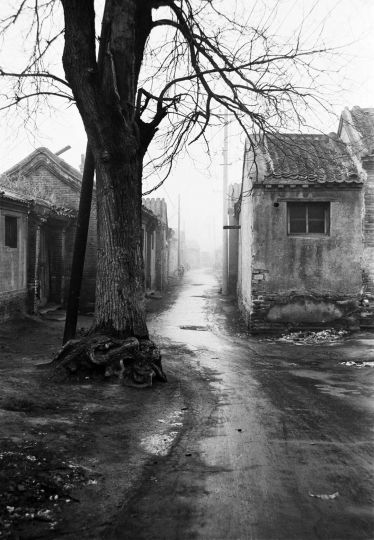Book shortlisted for Paris Photo 2015 Aperture Foundation Photobook Awards
In the world today dominated by digital photography, few have the notion of “negatives”, therefore when we are confronted with a negative photograph, printed as such in a book, or blown up in a large print on the wall, our eye aches from the discomfort that stems from our attempt to watch. Probably this is one deliberately subconscious intention of photographer Xu Yong, author of these images, who decided 25 years after he took them with his 35mm Konica, to have them published as such, instead of “positives” in a book simply titled “NEGATIVES”.
The discomfort represents the physical manifestation of Roland Barthes’ punctum, this needling pain for those who still remember what had happened. Xu Yong explained himself why: “On the attempt to cover-up and induce amnesia on a historic event, negatives have more direct impact as evidence than normal photographs or social media”. To see the “evidence” requires an effort to bear the painful discomfort, forcing us to apprehend the image per se in its total abstraction. While the narrative power of photography is still resilient here, Xu Yong took pain to make it even harder for us to read his pictures: he has not only operated an inversion of the colors (the red color turns into blue and vice-versa), he has also inverted the direction of the words that appear in the images. Skies become dark ink night skies, spooky silhouettes of men wearing “white” hair, the slogans written in big characters on the banners they carry resemble some mysterious enigmatic hieroglyphs (from Greek for “sacred writing”), a blacked plaster statue supposedly the goddess of Democracy is looming large in the middle of the crowd, holding up a stony flame surrounded by flags and banners, perfectly centered frame of three layers of banners with justice demanding characters with the portrait of an indifferent and helpless helmsman hanging in the middle of the two “long live” slogans. Another white-haired bespectacled man gesturing while calling through a megaphone besides a sign that says “sign up for hunger strike”. These are among other poignant images some of the most striking that form this new set of conceptual re-production, a work of “revelation” of scenes that had existed in our collective subconscious but that had vanished a long time ago. Heroic poetic slogan that in retrospect read ominously like an ironic warning like in this big banner “sky will soon brighten up”, while the ending is doomed. Sometimes the negative print resemble classic frieze art such as in this image showing rows of helmeted soldiers sitting with in the foreground, a man in a visor cap both arms up shouting slogan and holding up a cardboard where one can read (in inverted Chinese) “the day the soldiers enter the scene, is the hour the people shed their blood”, a sort of a long-haired hippy waving a red banner as if to protect the protester from the soldiers sitting behind him.
For readers who want to see the “positives”, use your camera by inverting color effect to negative, and on iPhone or iPad, switch on setting > general > accessibility > invert color.
There was another implicit intention of Xu Yong in selecting 64 images – one image per every two pages – for his book, as the numbers 6-4 have become highly toxic in the official censordom of the largest country in the world. Starting with the negative number 01 where a diagonal divides the mass of peacefully gathered students from the mass of parked bicycles, to the negative 64 depicting a tank crashing the barricades.
Xu Yong said that he felt obliged to publish these pictures now, because he was getting old and the negatives turning yellow. Oddly, the power of these “Negatives” is precisely to help us recover our memory.
XU Yong, born in Shanghai in 1954, lives in Beijing, he has been one of the earliest artists to create the art district 798. A photographer who evolved from documentary to conceptual while consistently exploring the frontiers of time and memory through original and outstanding exhibitions and books:
“NEGATIVES”, hard cover 78 pages, 64 color photographs, published by New Century Press, Hong Kong 2015, and by Verlag Kettler in Germany 2015.
“THIS FACE”, 512 portraits or a day in the life of a sex worker, a hard cover book of 549 pages published by Culture of China Publication, Hong Kong 2011.
“18% GREY”, published in 2010 by Beijing Timezone 8. The book about “blurred memories” won the International Photobook Award of 2011 at Kessel Photobook Festival.
“101 Hutongs”, Zhejiang Photography Publishing, first edition in 1993, also in English “Xiao Fangjia Hutong”, China Photography Publishing House 2002.
BOOK
Negatives by Xu Yong
Hard cover, 78 pages
64 color photographs
Published by New Century Press, Hong Kong
and by Verlag Kettler en Allemagne (2015)
https://www.newcenturymc.com
http://www.verlag-kettler.de
http://www.photographyofchina.com/blog/xuyong

















